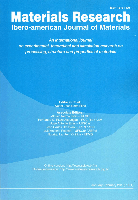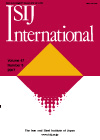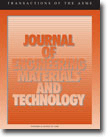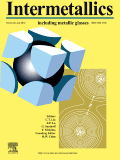
JOM
Scope & Guideline
Fostering collaboration in engineering research.
Introduction
Aims and Scopes
- Materials Processing and Manufacturing:
Research related to various methods of processing metals, alloys, and composites, including additive manufacturing, casting, welding, and surface modification techniques. - Mechanical Properties and Behavior:
Studies focusing on the mechanical characteristics of materials, including strength, ductility, fatigue, and wear resistance, often investigating the effects of different processing methods or alloy compositions. - Corrosion and Surface Engineering:
Exploration of corrosion resistance and surface treatment methods aimed at enhancing the durability and performance of materials in various environments. - Thermodynamics and Kinetics:
Research examining the thermodynamic principles governing material behavior, phase transformations, and kinetic processes in metallurgy and materials science. - Sustainable Materials and Recycling:
Investigations into the recycling of materials and the development of sustainable practices in materials processing, including the recovery of valuable metals from waste. - Nanomaterials and Composites:
Studies exploring the synthesis, characterization, and application of nanostructured materials and composite systems for advanced engineering applications. - Biomaterials and Biomedical Applications:
Research focused on the development and characterization of materials for biomedical applications, including implants and drug delivery systems.
Trending and Emerging
- Additive Manufacturing and 3D Printing:
The exploration of additive manufacturing technologies continues to gain momentum, with a focus on optimizing processes, materials, and applications in aerospace, biomedical, and automotive industries. - Machine Learning and Data-Driven Approaches:
Research utilizing machine learning and artificial intelligence to predict material properties, optimize processes, and analyze data is rapidly increasing, showcasing the integration of computational methods in materials science. - Sustainability and Circular Economy:
There is a growing emphasis on sustainable practices, including recycling, waste reduction, and the development of eco-friendly materials, reflecting global trends towards environmental responsibility. - Nanotechnology and Advanced Composites:
Emerging studies on nanomaterials and advanced composite systems highlight their unique properties and applications in various fields, including energy storage, catalysis, and biomedical applications. - Biomaterials and Bioinspired Design:
Research focused on biomaterials, particularly in biomedical applications, is trending, as is the exploration of bioinspired materials that mimic natural systems for innovative solutions. - Corrosion Resistance and Surface Treatments:
Innovative approaches to improve corrosion resistance through novel coatings and surface treatments are increasingly relevant, driven by the need for durable materials in harsh environments.
Declining or Waning
- Traditional Metallurgy:
Research focusing solely on conventional metallurgical processes and operations has seen a decline as newer, more advanced methods such as additive manufacturing gain prominence. - Raw Material Extraction Techniques:
Papers specifically centered around traditional extraction methods for metals from ores or concentrates are being overshadowed by studies focused on recycling and sustainable practices. - Static Analysis of Material Properties:
The focus on purely static mechanical properties without consideration of dynamic or real-world applications is becoming less relevant as the field moves towards more applied and experimental methodologies. - Single-Material Studies:
Research that concentrates on single materials without exploring composites or hybrid systems is declining as the industry increasingly seeks multifunctional and multi-material solutions. - Basic Research Without Industrial Application:
Papers that do not align with practical applications or industrial relevance are less frequently published, as journals emphasize research that can lead to tangible advancements in technology.
Similar Journals

Materials Research-Ibero-american Journal of Materials
Empowering researchers with open access to cutting-edge insights.Materials Research-Ibero-american Journal of Materials, published by the UNIV FED SAO CARLOS, DEPT ENGENHARIA MATERIALS, is a prominent platform dedicated to advancing the field of materials science. Launched in 1998, this Open Access journal has fostered a culture of inclusive knowledge sharing, allowing researchers and practitioners worldwide to access valuable insights in Condensed Matter Physics, Materials Science, Mechanical Engineering, and Mechanics of Materials. With a commendable Q3 ranking in these diverse categories in 2023, the journal provides a vital resource that bridges theoretical research and practical applications in materials technology. Covering a range of topics from novel material characterization to innovative engineering solutions, Materials Research serves as a critical forum for contributors across the globe, particularly those in Latin America. Researchers, students, and professionals are encouraged to engage with this journal, which operates with a clear commitment to high standards and is based in São Carlos, Brazil, further enhancing its relevance and appeal within the international materials research community.

SURFACE REVIEW AND LETTERS
Unveiling Insights in Surface ScienceSURFACE REVIEW AND LETTERS, published by WORLD SCIENTIFIC PUBL CO PTE LTD, is a pivotal journal in the fields of condensed matter physics, materials chemistry, and surfaces and interfaces. With an ISSN of 0218-625X and an E-ISSN of 1793-6667, this journal serves as a platform for cutting-edge research and innovative developments from 1996 to 2024. Despite its classification in the Q4 and Q3 quartiles for various categories in 2023, SURFACE REVIEW AND LETTERS emphasizes the importance of inter-disciplinary collaboration and the rapid dissemination of valuable insights, making it an essential resource for researchers and professionals eager to stay at the forefront of material science. Although currently lacking an open access option, the journal invites a wide range of submissions—fostering knowledge sharing among scholars and contributing to the advancement of the scientific community. Aspiring authors and readers will benefit from the opportunity to engage with diverse studies and methodologies, underscoring the journal's commitment to excellence in materials research.

Materials Physics and Mechanics
Exploring the Mechanics of Tomorrow's MaterialsMaterials Physics and Mechanics is a pivotal journal dedicated to advancing the fields of condensed matter physics, materials science, mechanical engineering, and the mechanics of materials. Published by the Institute of Problems in Mechanical Engineering, Russian Academy of Sciences, this journal has established itself as a valuable resource since its inception, particularly from 2003 to 2004 and now continuously from 2009 to 2024. Although it currently holds a Q4 categorization in various disciplines, its contributions are critical to understanding and developing new materials and their applications in engineering. The journal provides insightful articles that explore the nuances of material properties, their behaviors under different conditions, and the physical principles governing these phenomena. Though it operates under a traditional publication model, the insights provided within its pages are invaluable to researchers, professionals, and students striving to push the boundaries of knowledge in the materials domain. Its ISSN numbers (1605-2730, E-ISSN 1605-8119) serve as a gateway to a wealth of scientific knowledge emanating from the Russian Federation, contributing to the global discourse in materials physics and mechanics.

RARE METAL MATERIALS AND ENGINEERING
Advancing Innovations in Rare Metal EngineeringRARE METAL MATERIALS AND ENGINEERING is a vital academic journal dedicated to advancing the fields of materials science, engineering, and metallurgy. Published by the NORTHWEST INST NONFERROUS METAL RESEARCH in China, this journal has been an essential resource for researchers and professionals since its inception in 1993. With a focus on rare metals and their engineering applications, the journal addresses contemporary issues and innovations in materials chemistry and electronic engineering, providing insights into the properties and uses of advanced materials. Although it currently falls within the Q4 category for several categories, including Electrical and Electronic Engineering and Materials Chemistry, its commitment to quality and relevance in the field is evident. The journal offers a platform for researchers to share their findings with the scientific community, fostering collaboration and knowledge exchange in an important area of study. Researchers and students interested in exploring the latest in rare metal technologies and engineering methodologies will find this journal a valuable addition to their academic library.

Uspekhi Fiziki Metallov-Progress in Physics of Metals
Fostering Collaboration in Metal PhysicsUspekhi Fiziki Metallov - Progress in Physics of Metals, published by the G V KURDYUMOV INST METAL PHYSICS NAS UKRAINE, is a distinguished open-access journal that has been advancing the field of metal physics since 2000. With an ISSN of 1608-1021 and E-ISSN of 2617-0795, this journal is pivotal for disseminating rigorous research findings and innovations across diverse subfields including Condensed Matter Physics, Electronic, Optical and Magnetic Materials, and Fluid Flow and Transfer Processes. The journal's strong impact, reflected in its Q2 and Q3 quartile rankings across several categories and a commendable Scopus ranking, places it at the forefront of materials science and engineering. Researchers, professionals, and students can benefit from its rich repository of high-quality articles aimed at fostering knowledge and collaboration in metal physics. With an accessible repository and commitment to the open-access model, Progress in Physics of Metals strives to make significant contributions to the global scientific community, shaping the future of metal-based research.

METALS AND MATERIALS INTERNATIONAL
Connecting researchers to the forefront of materials science.METALS AND MATERIALS INTERNATIONAL, published by the Korean Institute of Metals and Materials, is a prestigious journal dedicated to the advancement of research in the fields of materials science and engineering. With an ISSN of 1598-9623 and a robust e-ISSN of 2005-4149, this journal has established itself as a crucial platform for disseminating innovative findings and key advancements that span condensed matter physics, materials chemistry, mechanics of materials, and the technology of metals and alloys. Its Q1 rankings in multiple categories attest to its high impact and relevance in the academic community, placing it among the top journals in its fields with Scopus rankings that reflect a strong international footprint. Here, researchers, professionals, and students can access cutting-edge research and insights, fostering collaboration and exploration of new materials and their applications. With a commitment to excellence and a convergence of knowledge from 1996 to 2024, METALS AND MATERIALS INTERNATIONAL continues to enhance our understanding of materials and their transformative impact on technology and engineering.

ISIJ INTERNATIONAL
Exploring the Frontiers of Materials Chemistry and EngineeringISIJ INTERNATIONAL is a distinguished open-access journal in the fields of Materials Chemistry, Mechanical Engineering, Mechanics of Materials, and Metals and Alloys, published by the esteemed IRON STEEL INST JAPAN KEIDANREN KAIKAN. Since its inception in 1986, ISIJ INTERNATIONAL has played a pivotal role in disseminating advanced research and critical findings in steel and iron industries, significantly contributing to innovations in materials science and engineering. With a commendable impact factor and categorized in Q2 quartiles across its relevant fields in 2023, the journal ranks favorably among other prestigious publications, evidencing its influence and relevance within the academic community. The journal promotes open access, allowing unrestricted online access to its published work since 2012, thus ensuring that researchers, professionals, and students can readily access cutting-edge research. The journal's comprehensive scope empowers researchers to connect over pioneering studies and methodologies that address contemporary challenges in materials and engineering domains, thereby fostering a rich dialogue and knowledge exchange.

JOURNAL OF ENGINEERING MATERIALS AND TECHNOLOGY-TRANSACTIONS OF THE ASME
Pioneering advancements in engineering materials and applications.JOURNAL OF ENGINEERING MATERIALS AND TECHNOLOGY-TRANSACTIONS OF THE ASME is a premier journal published by the American Society of Mechanical Engineers (ASME), dedicated to advancing the field of engineering materials and technology. With an ISSN of 0094-4289 and E-ISSN 1528-8889, this journal has provided invaluable insights since its inception in 1973. Operating from its headquarters in New York, United States, it serves a global audience of researchers, professionals, and students alike. The journal is recognized for its rigorous peer-review process and its commitment to disseminating high-quality research, currently holding a Q3 quartile ranking across multiple categories including Condensed Matter Physics, Materials Science, Mechanical Engineering, and Mechanics of Materials. With a focus on exploring innovative materials and their applications, it aims to foster collaboration and discovery in the engineering community. Although it is not an open-access journal, it continues to play a vital role in shaping the future of engineering materials research up to 2024. Researchers and practitioners will find in this journal a significant platform to support the development and understanding of engineering materials, making contributions that resonate through academia and industry.

METALLURGIA ITALIANA
Illuminating the Path of Metallurgical ResearchMETALLURGIA ITALIANA, an esteemed journal published by the ASSOCIAZIONE ITALIANA METALLURGIA, specializes in the fields of condensed matter physics, mechanics of materials, and metals and alloys. With a history spanning from 1969 to 2024, this Italian journal has consistently contributed to the scholarly conversation surrounding metallurgical sciences and materials engineering. Despite its Q4 ranking in several categories, the journal provides a critical platform for emerging research and advancements in metallurgy, encouraging interdisciplinary dialogue among academics, professionals, and students. Readers can benefit from valuable insights into the latest developments and applications in the field, supported by the journal's commitment to fostering academic rigor and innovation. While access options currently do not include open access, METALLURGIA ITALIANA remains a cherished resource for those dedicated to exploring the nuances of material properties and applications.

INTERMETALLICS
Connecting Chemistry and Engineering through IntermetallicsINTERMETALLICS, a prestigious journal published by ELSEVIER SCI LTD in the United Kingdom, has been a vital resource in the fields of Materials Science, Mechanical Engineering, and Chemistry since its inception in 1993. Renowned for its rigorous peer-review process and commitment to high-quality research, this journal enjoys an impressive position within the top quartile (Q1) rankings of its categories, signifying its influence and esteem in the academic community. With a particular emphasis on the study of intermetallic compounds and their applications, INTERMETALLICS attracts groundbreaking research and innovative contributions that push the boundaries of knowledge in metals and alloys, as well as mechanics of materials. Researchers looking for a platform to disseminate cutting-edge findings will find this journal an exemplary choice, further enhanced by its commendable Scopus rankings that illustrate its widespread recognition and relevance. Though it does not currently offer Open Access options, the journal remains committed to advancing the field through selective publication of impactful research, making it an essential reference for researchers, professionals, and students alike interested in the dynamic interplay between materials and engineering.